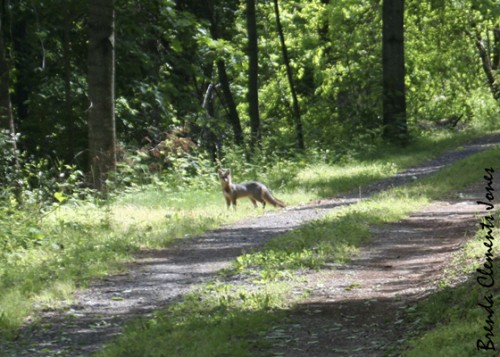Until I moved to my cabin in the Blue Ridge Mountains, if I had any thoughts of a fox, it was a Red Fox, Vulpes vulpes, with a rusty red coat, black legs and white tipped tail. I quickly learned that there is another fox that lives up here at 1800 feet. Slightly smaller than a Red Fox, the Gray Fox, Urocyon cinereoargenteus, generally weighs between 8 and 15 pounds, and in length is between 30 and 44 inches, with about one third of that being its tail. The male Gray Fox is usually larger than the female.
The coloring of the Gray Fox is salt and peppery on his back. His sides, back of his head and legs are rusty red, reminiscent of the Red Fox. His long, lush tail is the same salt and pepper as his back, with a stripe of black on top. Unlike the Red Fox, the Gray Fox has no snow white tip on his tail but a tip of coal black. A new born kit is generally dark brown.
The Gray Fox has an elegant, long, very strong neck. He is equipped with hooked claws, which allows him to easily climb trees, to escape predators or to forage for fruit. To get down from the tree, he will bound from branch to branch, or comes down backward, as a house cat would do.
The Gray Fox is an omnivore, dining on cottontails, mice, voles, shrews, insects, as well as birds. But I became aware of the Gray Fox as he would come to eat the sunflower seeds that I put out for the birds. Yes, like Black Bears, Gray Fox also eat seeds and berries! They also eat roots and tubers. If their food supply is plentiful, they will cache their extras, digging a hole with their forepaws and burying the extras.
The Gray Fox is monogamous and has a gestation period of 53 days with the litter size ranging from 1 to 7 kits. The life span of a Gray Fox is from 6 to 8 years, both in the wild and in captivity. Predators of the Gray Fox are Bobcats, Great Horned Owls, Coyotes and Golden Eagles. Along with escaping by climbing trees, they will hide in brush piles or other cover to avoid capture.
The Gray Fox prefers the isolation of deep woods, while the Red Fox is more adaptable and can deal with changes that humans present to their territory. The Gray Fox sounds like me in that respect. I enjoy my home far from the maddening crowd!
Along with so many other critters that live in these woods around my home, the Gray Fox is a welcome sight, and one that delights me whenever one or two stop by for a visit.




